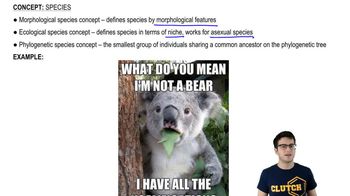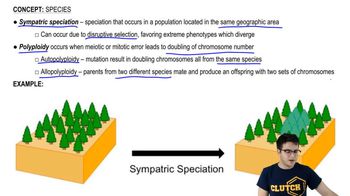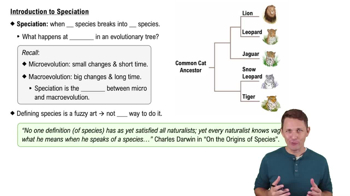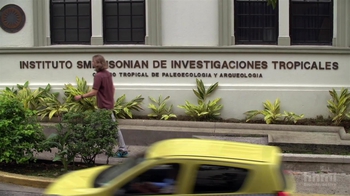Table of contents
- 1. Introduction to Biology2h 42m
- 2. Chemistry3h 40m
- 3. Water1h 26m
- 4. Biomolecules2h 23m
- 5. Cell Components2h 26m
- 6. The Membrane2h 31m
- 7. Energy and Metabolism2h 0m
- 8. Respiration2h 40m
- 9. Photosynthesis2h 49m
- 10. Cell Signaling59m
- 11. Cell Division2h 47m
- 12. Meiosis2h 0m
- 13. Mendelian Genetics4h 44m
- Introduction to Mendel's Experiments7m
- Genotype vs. Phenotype17m
- Punnett Squares13m
- Mendel's Experiments26m
- Mendel's Laws18m
- Monohybrid Crosses19m
- Test Crosses14m
- Dihybrid Crosses20m
- Punnett Square Probability26m
- Incomplete Dominance vs. Codominance20m
- Epistasis7m
- Non-Mendelian Genetics12m
- Pedigrees6m
- Autosomal Inheritance21m
- Sex-Linked Inheritance43m
- X-Inactivation9m
- 14. DNA Synthesis2h 27m
- 15. Gene Expression3h 20m
- 16. Regulation of Expression3h 31m
- Introduction to Regulation of Gene Expression13m
- Prokaryotic Gene Regulation via Operons27m
- The Lac Operon21m
- Glucose's Impact on Lac Operon25m
- The Trp Operon20m
- Review of the Lac Operon & Trp Operon11m
- Introduction to Eukaryotic Gene Regulation9m
- Eukaryotic Chromatin Modifications16m
- Eukaryotic Transcriptional Control22m
- Eukaryotic Post-Transcriptional Regulation28m
- Eukaryotic Post-Translational Regulation13m
- 17. Viruses37m
- 18. Biotechnology2h 58m
- 19. Genomics17m
- 20. Development1h 5m
- 21. Evolution3h 1m
- 22. Evolution of Populations3h 52m
- 23. Speciation1h 37m
- 24. History of Life on Earth2h 6m
- 25. Phylogeny2h 31m
- 26. Prokaryotes4h 59m
- 27. Protists1h 12m
- 28. Plants1h 22m
- 29. Fungi36m
- 30. Overview of Animals34m
- 31. Invertebrates1h 2m
- 32. Vertebrates50m
- 33. Plant Anatomy1h 3m
- 34. Vascular Plant Transport1h 2m
- 35. Soil37m
- 36. Plant Reproduction47m
- 37. Plant Sensation and Response1h 9m
- 38. Animal Form and Function1h 19m
- 39. Digestive System1h 10m
- 40. Circulatory System1h 57m
- 41. Immune System1h 12m
- 42. Osmoregulation and Excretion50m
- 43. Endocrine System1h 4m
- 44. Animal Reproduction1h 2m
- 45. Nervous System1h 55m
- 46. Sensory Systems46m
- 47. Muscle Systems23m
- 48. Ecology3h 11m
- Introduction to Ecology20m
- Biogeography14m
- Earth's Climate Patterns50m
- Introduction to Terrestrial Biomes10m
- Terrestrial Biomes: Near Equator13m
- Terrestrial Biomes: Temperate Regions10m
- Terrestrial Biomes: Northern Regions15m
- Introduction to Aquatic Biomes27m
- Freshwater Aquatic Biomes14m
- Marine Aquatic Biomes13m
- 49. Animal Behavior28m
- 50. Population Ecology3h 41m
- Introduction to Population Ecology28m
- Population Sampling Methods23m
- Life History12m
- Population Demography17m
- Factors Limiting Population Growth14m
- Introduction to Population Growth Models22m
- Linear Population Growth6m
- Exponential Population Growth29m
- Logistic Population Growth32m
- r/K Selection10m
- The Human Population22m
- 51. Community Ecology2h 46m
- Introduction to Community Ecology2m
- Introduction to Community Interactions9m
- Community Interactions: Competition (-/-)38m
- Community Interactions: Exploitation (+/-)23m
- Community Interactions: Mutualism (+/+) & Commensalism (+/0)9m
- Community Structure35m
- Community Dynamics26m
- Geographic Impact on Communities21m
- 52. Ecosystems2h 36m
- 53. Conservation Biology24m
23. Speciation
Introduction to Speciation
Problem 4`
Textbook Question
Which of the following is an example of a prefertilization barrier to reproduction?
a. A female mammal is unable to carry a hybrid offspring to term
b. Hybrid plants produce only sterile pollen
c. A hybrid between two bird species cannot perform a mating display
d. A male fly of one species performs a 'wing-waving' display that does not convince a female of another species to mate with him
e. A hybrid embryo is not able to complete development
 Verified step by step guidance
Verified step by step guidance1
Step 1: Understand the concept of reproductive barriers. Reproductive barriers are mechanisms that prevent species from interbreeding and producing viable offspring. These barriers can be classified into two main types: prefertilization (prezygotic) and postfertilization (postzygotic). Prefertilization barriers occur before the formation of a zygote, while postfertilization barriers occur after fertilization.
Step 2: Analyze the options provided in the question. Each option describes a scenario related to reproduction. Determine whether each scenario occurs before or after fertilization.
Step 3: Evaluate option (a): 'A female mammal is unable to carry a hybrid offspring to term.' This scenario involves a postfertilization barrier because it occurs after fertilization and involves the development of the hybrid offspring.
Step 4: Evaluate option (d): 'A male fly of one species performs a 'wing-waving' display that does not convince a female of another species to mate with him.' This scenario describes a behavioral barrier that prevents mating from occurring, which is a prefertilization barrier.
Step 5: Confirm that option (d) is the correct example of a prefertilization barrier to reproduction, as it prevents the formation of a zygote by inhibiting mating behavior between species.
 Verified video answer for a similar problem:
Verified video answer for a similar problem:This video solution was recommended by our tutors as helpful for the problem above
Video duration:
2mPlay a video:
Was this helpful?
Key Concepts
Here are the essential concepts you must grasp in order to answer the question correctly.
Prefertilization Barriers
Prefertilization barriers are mechanisms that prevent mating or fertilization between different species. These barriers can occur before the formation of a zygote and include various forms of reproductive isolation, such as behavioral, temporal, and mechanical isolation. Understanding these barriers is crucial for studying speciation and the maintenance of species boundaries.
Recommended video:
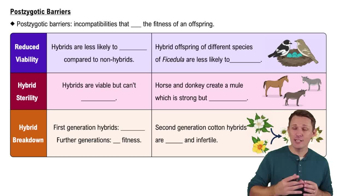
Postzygotic Barriers
Behavioral Isolation
Behavioral isolation is a type of prefertilization barrier where differences in mating behaviors or rituals prevent species from interbreeding. For example, if one species has a specific courtship display that another species does not recognize, they will not mate. This concept highlights the importance of mating signals and behaviors in reproductive success.
Recommended video:
Guided course

Behavior
Hybrid Viability and Fertility
Hybrid viability and fertility refer to the ability of hybrid offspring to survive and reproduce. While some hybrids may be born, they can be sterile or have reduced fitness, which limits gene flow between species. This concept is essential for understanding the consequences of hybridization and the evolutionary implications of reproductive barriers.
Recommended video:
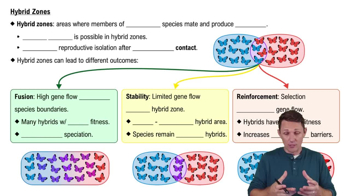
Hybrid Zones

 3:03m
3:03mWatch next
Master Introduction to Speciation with a bite sized video explanation from Jason
Start learningRelated Videos
Related Practice



